Buying an American-Made Vintage Wristwatch
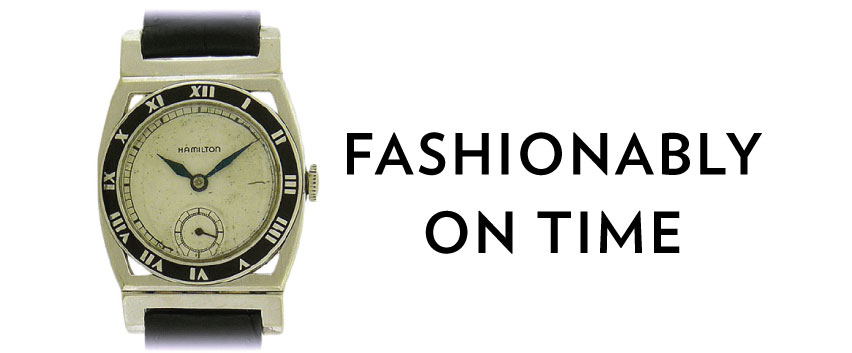
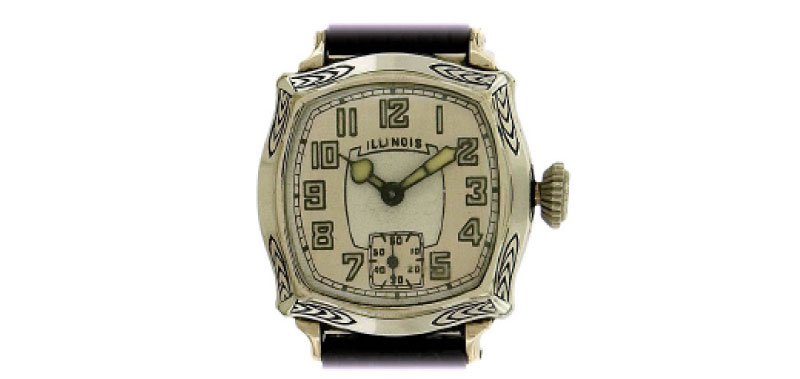
White gold-filled Art Deco Illinois ‘Jolly Roger’ with 34mm x 38mm case, decoratively engraved bezel, distincitvely curved square case design, produced in 1930.
 Rare 18K gold Gruen Curvex, Precision, cira 1940’s measures 24mm x 39mm, with chevron faceted hooded lugs, matte silver dial with applied gold Arabic nuermals.
Rare 18K gold Gruen Curvex, Precision, cira 1940’s measures 24mm x 39mm, with chevron faceted hooded lugs, matte silver dial with applied gold Arabic nuermals.
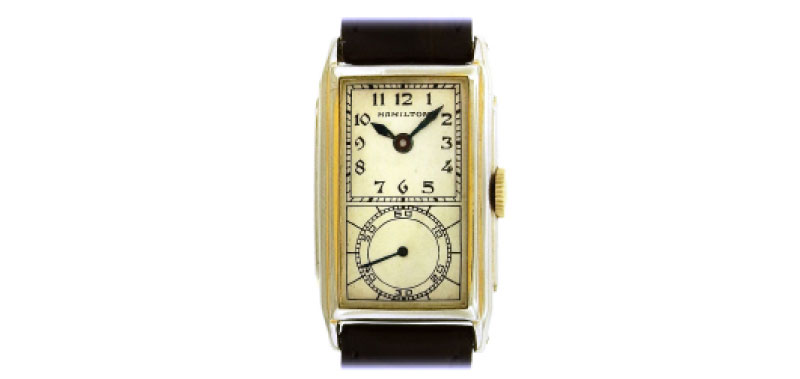
Yellow gold-filled Hamilton ‘doctor’s watch’ named for its double dial, the upper half for hours and minutes, the lower half for seconds, circa late 1930’s.
 Extremely rare Illinois two-tone 14K white and yellow solid gold ‘Tuxedo’ wristwatch, circa 1929, is a 23mm x 36mm rectangular silhouette
Extremely rare Illinois two-tone 14K white and yellow solid gold ‘Tuxedo’ wristwatch, circa 1929, is a 23mm x 36mm rectangular silhouette
 Bulova Military Automatic stainless steel mround wristwatch, 33mm, with a screwed-down back, inclined bezel, silver dial, luminous Arabic hour numbers.
Bulova Military Automatic stainless steel mround wristwatch, 33mm, with a screwed-down back, inclined bezel, silver dial, luminous Arabic hour numbers.
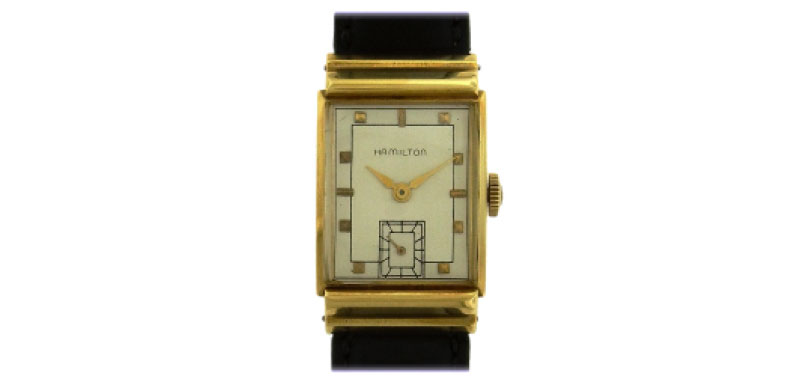
Rare 18K gold Hamilton “Gordon” tank, circa 1952,–rectangular, 22mm x 27mm with beveled stepped hooded lugs, silver dial with applied pyramidal hour indexes, subsidiary seconds register, gold dauphine hands and domed crystal.
By Hans Gschliesser
In homage to all of you jewelry possessed women waiting for their next fix—here is a story of how I became obsessed with the unexpected gift of an 18k rose gold vintage 1940s Elgin watch.
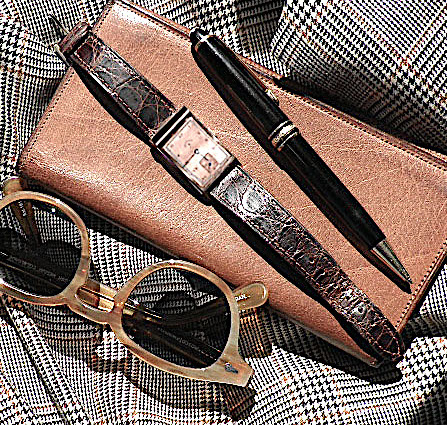
Elgin 18K gold rose gold watch, circa 1940s
Before receiving the gift, I had never been a man who wore jewelry, not even a wedding band (although I have been happily married for many years). Accessorizing is not my style. And, similar to the way I would never wear a bowler hat or spats, wearing a timepiece became an antiquated notion to me. Why even bother wearing a watch, when the time was everywhere? I realized this around 20-25 years ago when I noticed that I could check the time on my cell phone, computer, television, car and microwave.
However, I was totally impressed when the oversized, sports and divers watches laden with complications surfaced in the watch market but couldn’t fathom wearing something as big as an alarm clock on my wrist. Unless of course I was stranded in Timbuctoo or decided to take a deep dive a la Jacques Cousteau. If I sported such a huge timepiece I felt it would drown my understated style—which ultimately consists of jeans, a sport shirt, a classically-tailored sport coat and the occasional cashmere sweater.
But then my friend, the jewelry expert presented me with an alluring Elgin timepiece and said, “this is going to look striking on your wrist and won’t mess with your ‘real guy’ persona. You’ll be channeling the distinctive way Clark Gable or Gary Cooper showed off their favorite Cartier Tanks.”
Gable and Cooper, She knew how to get me interested. She said she saw me more as an American wristwatch sort of guy. “ Hmmm, I initial thought—shouldn’t I be one of those serious Swiss watch connoisseur types? I have taste and an image to uphold. “Excuse me. Image?” she questioned, “You check your microwave to see when you need to leave for work in the morning.”
And then she sent me the watch. I was shocked. It had a beveled crystal, and as far as mechanical watches go, it ran like clockwork (pun intended) and she was right—It did suit my wrist and seemed to be one of those watches with details and design elements in all the right places, the size and shape of which were just classic enough to not turn me into trendy retro guy. Instead, it gave me a sense of time-worn luxury.
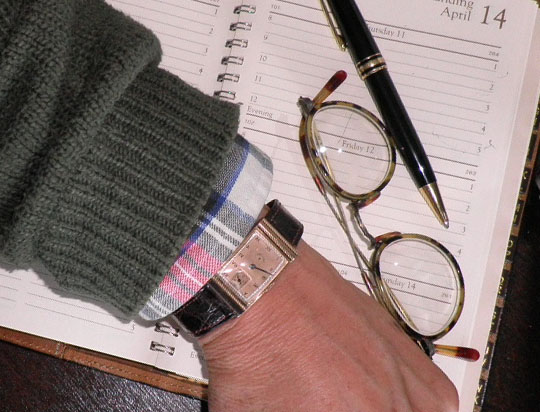
Elgin Rose 18K rose gold watch, circa 1940s
Along with the gift, she sent a note explaining an important historical fact: in addition to a handful of smaller manufacturers, the oldest of the larger American brands was Elgin, which was founded in 1867.
I was sold, so much so that – dare I say it – I started revolving my clothes around the watch much in the way women match their clothes to the jewels. In other words, I became obsessed.
The time had come to stop thinking of my cell phone as a substitute for a creatively designed watch. I don’t consider a smartwatch in that category and never wanted to own one –I was already surrounded by too much harried digital technology The charm of a vintage mechanical style seemed to slow down time for me. I realized that every day the simple act of winding this amazing piece of craftsmanship and ingenuity gave me pleasure.
It’s true, there are only a few items of jewelry that most men will wear. And the easiest is a watch—even if they are as stubborn as me. Whether a modern or vintage watch style depends on the man—but the more I learned about the history of early American-made watches, the more I became a fan. So I decided to try my hand at starting a small collection which I could rotate with either jeans and a T-shirt or sweater or dress shirt and blazer – these would tick with my choices and make great conversation pieces.
The antique patina and handsome designs of early American watches offer versatility and a sense of history. These timepieces also communicate substance and a commanding presence that belies the personality of the guy who wears them. They say, “I am solid, reliable and I will be here.”
I embarked on an internet search for other vintage watches. After spending the time investigating, I figured I should share the tips I learned about the American-made watches with all you women whose men might feel the same way about them as I do.
I came across Aaron Faber Gallery –one of the premier watch shops in the U.S. whose owner Ed Faber is co-author of the book American WristWatches: Five Decades of Style and Design (Schiffer, 1996). In his store, Faber carries both American and Swiss-made brands and some of his prices go up into the six figures and even higher for his most rare Swiss pieces, yet he waxes poetic on the early American-made timepieces.
I contacted them by phone to gather more information on the history of different brands and those he thinks are most collectible and an investment.
He explains, “The American mechanical watch industry produced a rare and desirable product. There is definitely a renewed interest among a wide demographic of men for timepieces that combine style, innovation of design and quality and are more accessibly priced, which are all attributes of vintage American wristwatches.” Faber reports, “company’s like Hamilton, Gruen and Elgin not only developed the function of accuracy in mechanical watches but also a variety looks, which all appear as modern today as they did in the period they were made.”
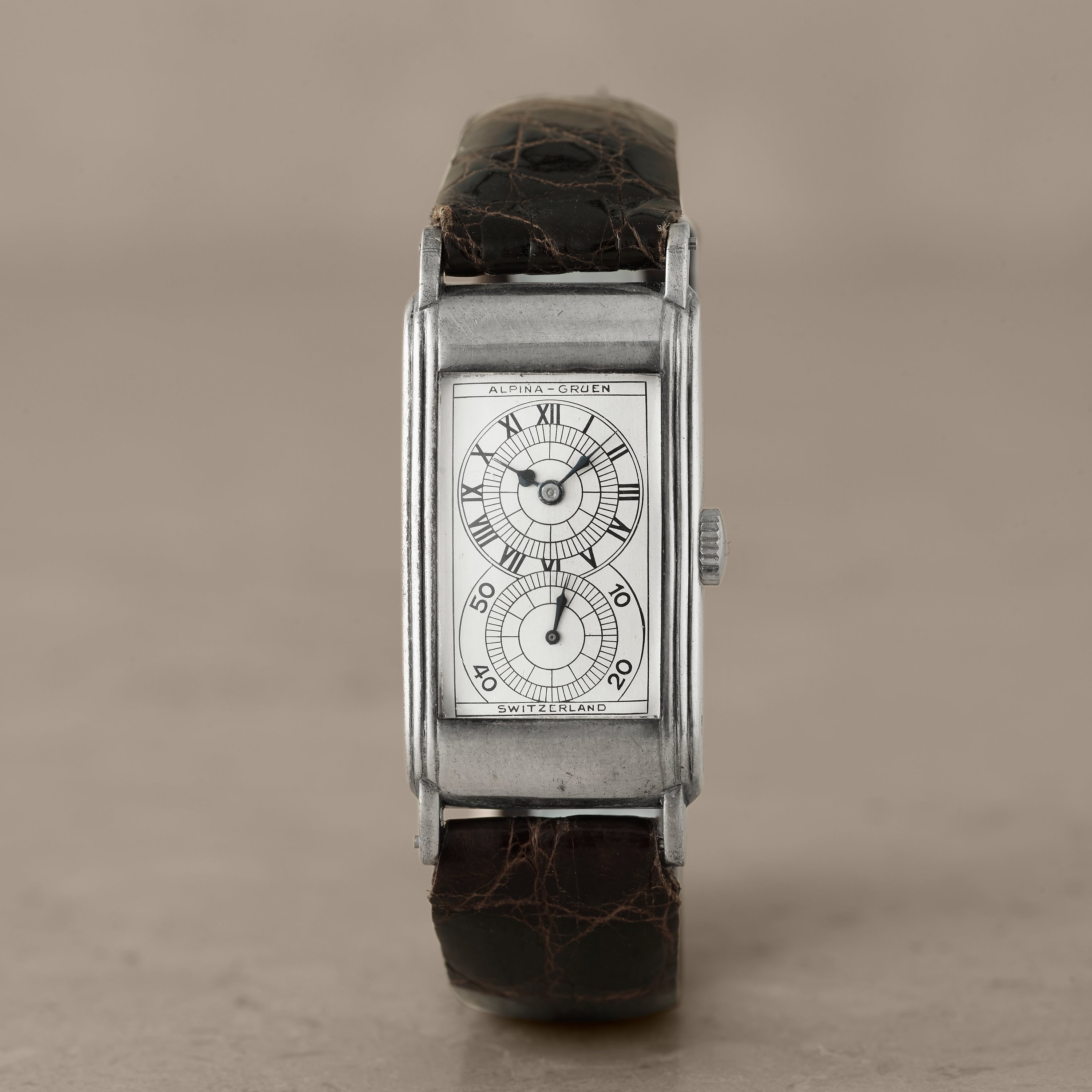
Greun Alpina Doctor’s Watch
He also provides insight into the big American-made brands and when they came onto the scene: After Elgin, came Illinois in1869, Gruen in 1874, Bulova in 1875, Ball in 1879, Ingersol in 1881, (which later became U.S. Time and then Timex in the mid 20th century), Waltham in 1885, and Hamilton in 1892. “ Of all of these, only Gruen, Bulova and Ball produced movements in Switzerland.
I ask him if there are specific attributes to look for in the different brands that he mentioned as well as other American-made watches.
“Illinois took the most risks and produced particularly fashionable case and dial designs, creating some of the most unique Deco looks.” He continues, “Hamilton’s watch have 19 jewel movements, which make them more accurate and more collectible in today’s market. Elgin’s output of production surpassed any of the competition and the company created more variety of stylized designs. Gruen developed the Curvex, which allowed the watch to be elongated and curved with the wrist.”
“In addition,” Faber explains, “Dials were fashioned with radium numerals and also became more interesting in numeral location. Printing directly on the dial gave it a dimensional quality. There was innovation and advancement in all of the parts of time-pieces, from removable pins to flexible lugs, fixed cases and metal dials.”
However, when it comes to buying vintage watches, looks aren’t everything. “When shopping around for timepieces, speak to a jeweler you trust and ask about the maker, the metal, and look for the most interesting designs,” says Faber. “If you’re drawn to a vintage watch, always inquire if all of the parts are original, how many jewels, if it’s triple-signed, and about the service and warrantee.”
As far as service is concerned, be careful not to expose leather or skin straps to water. If you notice a crack in the crystal, bring it in as soon as possible to be replaced.
Since time waits for no man I will continue finding other vintage watches that will suit my style or better yet– style my suit! And hope that I’ve passed along enough information so your man can do the same.

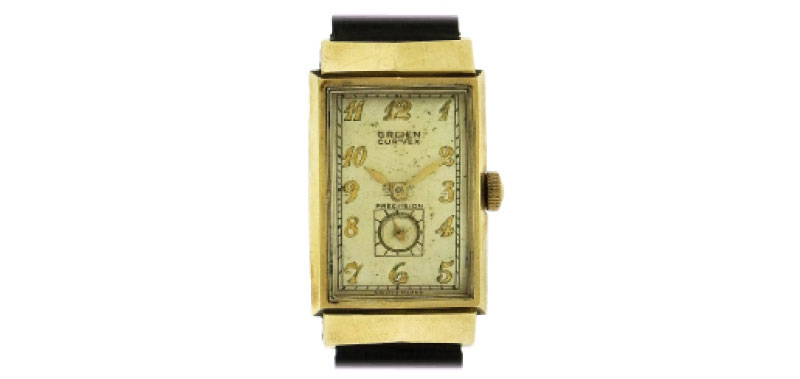 Rare 18K gold Gruen Curvex, Precision, cira 1940’s measures 24mm x 39mm, with chevron faceted hooded lugs, matte silver dial with applied gold Arabic nuermals.
Rare 18K gold Gruen Curvex, Precision, cira 1940’s measures 24mm x 39mm, with chevron faceted hooded lugs, matte silver dial with applied gold Arabic nuermals.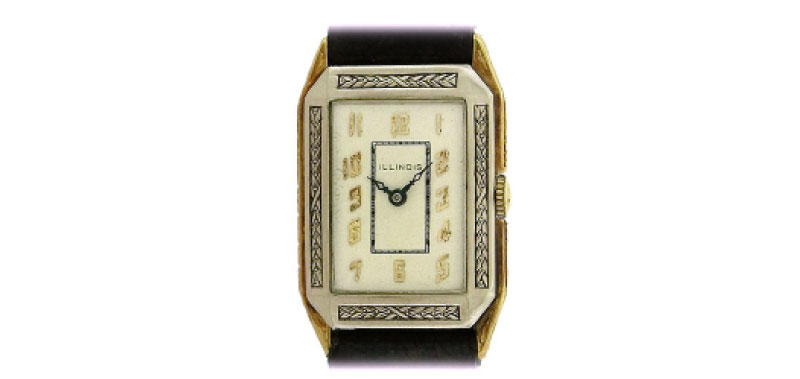 Extremely rare Illinois two-tone 14K white and yellow solid gold ‘Tuxedo’ wristwatch, circa 1929, is a 23mm x 36mm rectangular silhouette
Extremely rare Illinois two-tone 14K white and yellow solid gold ‘Tuxedo’ wristwatch, circa 1929, is a 23mm x 36mm rectangular silhouette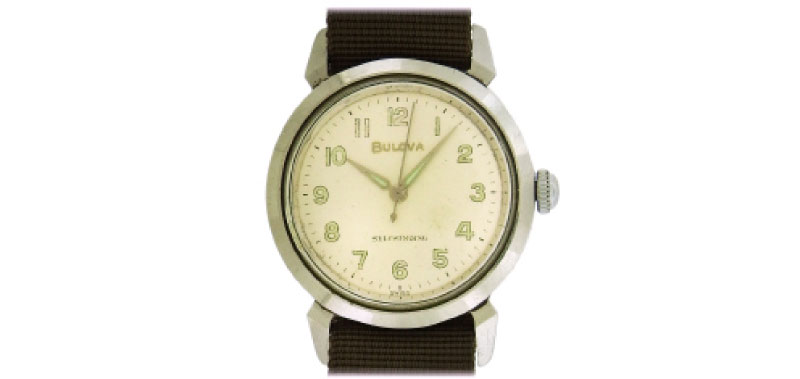 Bulova Military Automatic stainless steel mround wristwatch, 33mm, with a screwed-down back, inclined bezel, silver dial, luminous Arabic hour numbers.
Bulova Military Automatic stainless steel mround wristwatch, 33mm, with a screwed-down back, inclined bezel, silver dial, luminous Arabic hour numbers.


